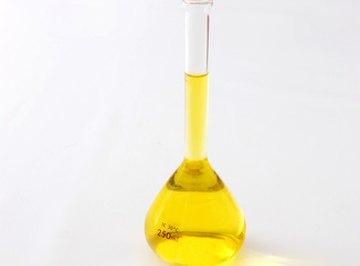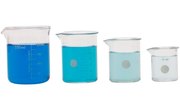
When conducting a scientific experiment it is necessary to know that you have the correct concentration of the different chemicals involved. It is also important to be able to calculate concentration in order to determine how much of a reactant has been used up in a reaction or how much product has been made.
To this end, scientists use the Beer-Lambert Law (which can also be called "Beer's Law") in order to calculate concentration from absorbance. The following section will define some key components for practical use of Beer's Law.
What Is the Beer-Lambert Law?
This law relates the attenuation of light as it traverses a material to the physical properties of that material. One of the most common uses of this law makes use of UV-Vis absorption spectroscopy.
Say you shine some visible light through a material. Some of that light will pass through on the other side of the material, but it will likely not be all of the light that was initially shone through. Whatever light does not pass through to the other side is absorbed.
The amount of light absorbed is proportional to the length of the light path (l). Practically, this is the container, usually a cuvette, in which the material in question is held.
The relationship between absorbance and concentration (c) is proportional. Usually, the more concentrated a substance, the more light will be absorbed. (Keep this quantity in mind; practically speaking, it's what you're the most interested in!).
Thus the absorbance (A) of the material is related to the initial intensity of the light, I0, and the transmitted intensity of the light (what came through on the other end), I. These quantities can be related by the following equation.
Since you know that absorption is proportional to both concentration (c) and path length (l), you can relate that to the quantities in this equation as such:
In this equation, ϵ is the molar absorptivity or the molar extinction coefficient. This value is a coefficient and is intrinsic to the absorption of the substance or material in question at a particular wavelength of light.
Units and Beer's Law
As it is always necessary for practical application of equations, you must know the units of each component involved.
Concentration (c) has a concentration of M or moles per liter (mol L-1). The light path (l) is usually reported in centimeters (cm). The molar absorptivity is usually reported in liters per mole-centimeter (L mol-1 cm-1). When multiplying c, l and ϵ, all the units cancel. As such, it follows that absorbance is unitless.
Using Beer's Law To Calculate Concentration
Say you have a red dye in a solution. How would you calculate the concentration of dye in the solution?
The food dye Red #40 has a molar absorptivity of 25,900 L mol-1cm-1 at a wavelength of 501 nm. You place 1 mL of the solution in a cuvette with a width of 1 cm. The measured absorbance is 0.17. What is the concentration?
Plug the known values (A, ϵ and l) into Beer's Law and then solve for concentration:
So:
Solving for concentration:
Talking about such a tiny molarity is a bit cumbersome. Scientists will often convert this to micromolar so that it is easier to talk about. To do this, multiply the number by 106. Thus the concentration of Red #40 in that solution is 6.56 µM.
References
Tips
- Graphing data and determining the equation of the best-fit line is greatly facilitated by using the graphing features of Microsoft Excel or a similar program. See Resources for a tutorial on graphing in Excel.
- Although Beer’s law states that absorbance and concentration are directly proportional, experimentally this is only true over narrow concentration ranges and in dilute solutions. Thus, standard solutions that range in concentration from, for example, 0.010 to 0.100 moles per liter will exhibit linearity. A concentration range of 0.010 to 1.00 moles per liter, however, will probably not.
About the Author
Riti Gupta holds a Honors Bachelors degree in Biochemistry from the University of Oregon and a PhD in biology from Johns Hopkins University. She has an interest in astrobiology and manned spaceflight. She has over 10 years of biology research experience in academia. She currently teaches classes in biochemistry, biology, biophysics, astrobiology, as well as high school AP Biology and Chemistry test prep.
Photo Credits
flask image by Hubert from Fotolia.com
